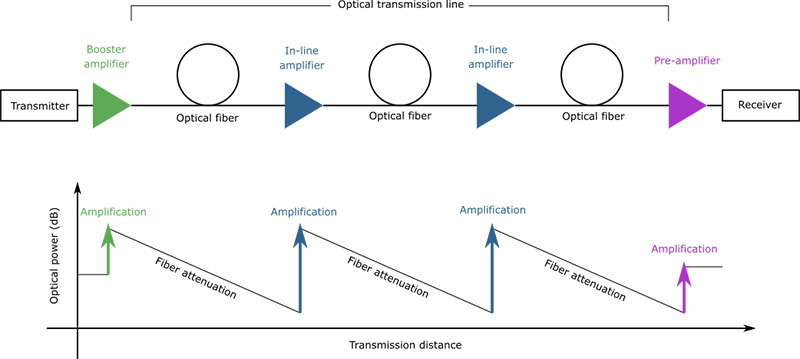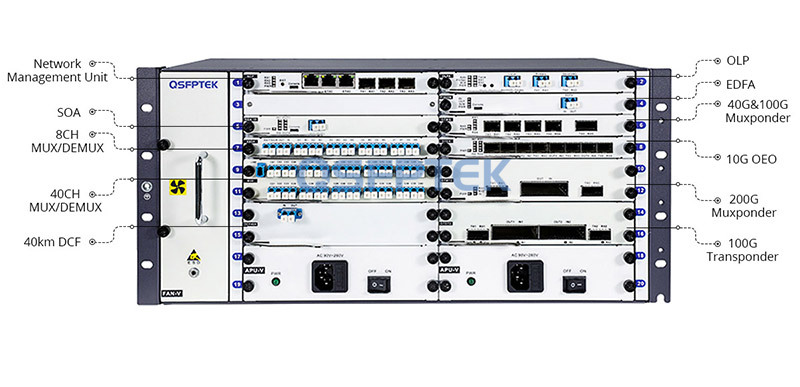What is EDFA Optical Amplifier for Long-Haul DWDM Networks?
Over the recent decades, the optical fiber network has fast deployment in telecommunication and wide application areas. EDFA is a type of fiber optic amplifier equipment, which has contributed to the fiber optic network. With the features of signal compensation and simultaneously amplifying multiple channels, the EDFA amplifiers are applied in DWDM networks for long-haul data transmission.
What is EDFA Amplifier?
EDFA (erbium-doped fiber amplifier) is an optical amplifier (OA) that operates in the C-band and L-band, where the fiber loss is the lowest. The optical signals will gradually deteriorate along the fiber optic transmission path in optical fiber communication. Consequently, to control the link attenuation (from fiber, connector, optical joint, etc) within acceptable thresholds, transmission distance is limited. This is where the EDFA comes in.

Figure 1: QSFPTEK EDFA amplifier
What is EDFA Used for?
Amplifiers are designed to enhance the optical signal to make it goes further for long-haul transmission applications. Given that EDFA features amplifying multiple optical signals simultaneously, it has wide adoption in WDM networks.

Figure 2: Booster, line and pre amplifiers are applied in long distance DWDM system
Drawing back to the era EDFA has not been invented, the technology to extend the reach of the optical signal is very complex and costly — optical-to-electrical signal conversion, signal amplification, and electrical-to-optical signal conversion. The EDFA amplifier saves the troubles of signal regeneration, providing an optimized technology to achieve simple and cost-effective signal power compensation.
What are the Types of EDFA Optical Amplifiers?
Booster Amplifier (BA), Line Amplifier (LA) and Pre Amplifier (PA) are the three types of EDFA applied in DWDM optical transmission lines. They are usually deployed in combination and placed at different positions on the line to make sure signals can finally be delivered to the receiver.

Figure 3: Booster, line and pre amplifiers placement in fiber optic line
Optical Booster Amplifier (OBA)
Fiber optic signal booster is often placed at the transmitter side to amplify the optical signal before it emits to the fiber link. Typically, it is installed closely after the Mux Demux equipment to compensate for the power loss of DWDM wavelengths or single wavelengths. Booster EDFA is designed with low gain and high output power to be combined with WDM multiplexing and demultiplexing technologies.
In-line Amplifier (OLA)
As the name indicates, optical line amplifiers are put in the transmission line to compensate for the link attenuation caused by signals transmitted through long-haul fiber links. Whether installing an inline amplifier is necessary or how many to deploy depends on the fiber link distance. Generally, an optical line amplifier will be placed every 80km in a long-haul fiber link. Adding LAs to the optical line is a solution to extend the transmission distance. The LA amplifiers feature moderate or high gains and share the same high output power as the BA.
Preamplifier (OPA)
The optical preamp is located close to each of the receiver sides to guarantee sufficient optical power can be detected by the receiver. The OPA is necessary for amplifying the optical signals to a required level after they go through a long fiber journey. Market optical preamplifier often provides high gains and lower output power.
As the above diagram shows, each of the transmitting sides and the receiving sides are correspondingly installed with a booster amplifier and a pre-amplifier to perform signal amplification after or before the WDM node. Besides, one or several line amplifiers are placed along the fiber transmission line to compensate for the power loss brought by fiber attenuation. OBA and OPA are used in pairs in converged DWDM networks, however, the OLA is selective for adoption in real applications, please check the transmission distance.
What is the EDFA Gain and EDFA Noise Figure?
The Gain and noise figure are key parameters to measure the quality of fiber optic amplifiers. They are usually assessed by launching multiple signals to the optical spectrum analyzer (OSA).
EDFA Gain
Simply put, the Gain of EDFA is the ratio of the optical output signal to the optical input signal. It is to measure the amplification degree the EDFA performs to the input signals. Depending on a different measured parameter of the optical power, the EDFA Gain can be Power Gain (Ap), Current Gain (Ai), or Voltage Gain (Av). However, what we mentioned about optical gain often refers to Power Gain. The input signal and output signal before and after going through the amplifier are shown in the picture below.

Figure 4: EDFA amplifier Gain diagram
Optical Voltage Gain = Output Voltage / Input Voltage
Optical Current Gain = Output Current / Input Current
Since Power = Voltage * Current, then:
Optical Power Gain = Optical Voltage Gain * Optical Current Gain = Output Voltage / Input Voltage * Output Current / Input Current
EDFA Noise Figure
The process of amplification generates Amplified Spontaneous Emission (ASE) noise, which will add to the signal and lead to a decrease in the signal-to-noise ratio (SNR) of the output. The ratio of input SNR to the output SNR is specified as Noise Figure (NF):
Noise Figure (NF) = Input SNR / Output SNR
QSFPTEK EDFA and Related Product Recommendation
QSFPTEK new arrivals for optical transport networking (OTN) include two EDFA amplifiers — QT8600-PA (Pre-amplifier) and QT8600-BA (booster amplifier).
They can be used symmetrically to extend signal reach in long-haul DWDM systems. Both can be integrated into the QT8600 series managed chassis platform, optional for 5U and 2U models. Besides, other same series OTN products, including OLP, DCM and transponders and muxponders can be used for a complete DWDM solution.

Figure 5: EDFA amplifiers and other products loaded in the 5U chassis platform
Summary
EDFA amplifier is a power compensation and signal amplification card module used for extending signal reach in fiber optic networks. The most popular usage of EDFA erbium-doped fiber amplifier is the DWDM network which has urgent needs for ultra-long transmission. Three types of EDFA optical amplifiers are Booster amplifiers, in-line amplifiers, and pre-amplifiers. Booster EDFA is installed at the transmitter end to amplify the signal before it reaches the fiber line. A line amplifier is put in the fiber line every 80km to compensate for the signal power. Pre-amplifier is placed before the receiver to ensure a sufficient power signal will launch to the receiver for detection.
If you still have questions on EDFA amplifiers or product quotations, please contact [email protected] for support. QSFPTEK will be glad to help.










